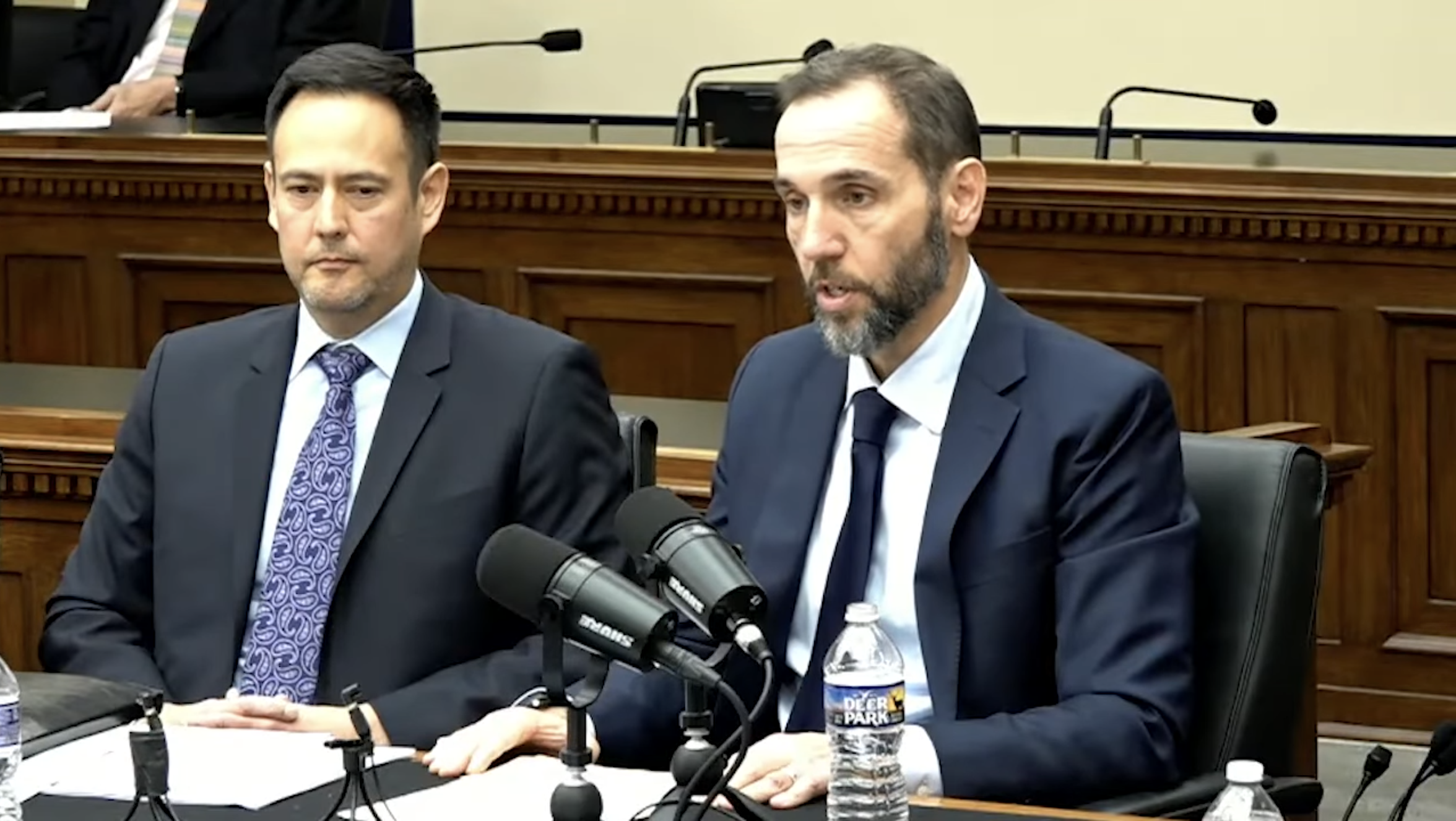Are Jan. 6 Defendants Getting a Fair Shake From D.C. Juries? Comparing Jury and Bench Trial Outcomes
.jpg?sfvrsn=eacf4886_3)
Published by The Lawfare Institute
in Cooperation With

On Monday, Jan. 23, after five guilty verdicts rolled in against high-profile defendants in Jan. 6-related federal criminal cases, defense lawyers for two of them gave predictable post-verdict press conferences. Each pointed the finger at the alleged bias of District of Columbia juries.
An attorney for Richard “Bigo” Barnett—the Arkansas man captured in an iconic photograph with his feet up on a desk in Speaker Nancy Pelosi’s suite with a stun-gun tucked into his belt—said Barnett had been denied a jury of his peers because the Washington, D.C., is “something like 95-96 percent Biden voters.” (He was a little off, but I take his point: Biden won 92.1 percent of the D.C. vote in 2020 and Hillary Clinton garnered 90.9 percent in 2016.)
That same day, after all four defendants in the second Oath Keepers seditious conspiracy trial were convicted of the top counts, an attorney for defendant Roberto Minuta likewise blamed the jury pool, though he stressed a different alleged failing: “We got a trial by residents of a small judicial district who in one way or another were almost all impacted by the events of January 6.”
Last August I published a post about Jan. 6 defendants’ attempts to flee the jurisdiction (“Escape From D.C.: Analyzing Jan. 6 Venue Transfer Motions”). I described then the legal landscape in which their motions to transfer venue are playing out, which is largely set by the District of Columbia Circuit’s binding, en banc 1976 ruling in United States v. Haldeman, affirming the convictions of the three top defendants in the Watergate scandal. Though I won’t rehearse here that earlier piece, I’ll highlight that the Haldeman court was particularly withering in its dismissal of the “odd” notion “that a community’s voting patterns are at all relevant to venue.” I concluded that the motions to transfer venue in the Jan. 6 cases were unlikely to gain traction unless they reached the U.S. Supreme Court. But if they did rise that far, I conceded, all bets were off.
The modest, circumscribed goal of this post is to see if some simple statistics might shed empirical light on whether D.C. juries are giving Jan. 6 defendants a fair shake. Here’s my ultra-simple methodology. Why not compare trial results in Jan. 6 cases before D.C. juries to trial results before D.C. judges presiding in bench trials without a jury to see if there is any disparity? Since experienced judges might be expected to curb their biases more skillfully than juries, whether emotional or political, we might expect to see a marked disparity in outcomes if D.C. jurors were truly unfair.
At this point, we now have a respectable dataset to work with.
According to my own, admittedly fallible, hand tallies of the relevant court documents, as of Jan. 27, there had been a total of 35 contested trials, including 19 jury trials and 16 bench trials. Because some contested trials have involved multiple defendants, a total of 47 defendants have had their cases adjudicated in these proceedings, including 28 before juries and 19 before judges. And since all trials involve multiple charges, a total of 287 criminal counts have now been resolved by trial—164 before juries and 123 before judges.
For those who hope that the system is working—that is, those who are not defense lawyers appealing their clients’ convictions—the results so far are encouraging. According to my unofficial tally, the government’s conviction rate in jury trials is almost identical to its conviction rate in bench trials. As of Jan. 26, the government had won convictions on 89 percent of the counts it had tried before juries (146 out of 164), while it had won convictions on 88 percent of counts it tried before judges (108 out of 123).
Of course, skeptics might not be assuaged if these bench trials were all presided over by judges appointed by Barack Obama or Joe Biden. Happily for our purposes, that is not the case. Even though most of the judges in the D.C. courthouse are appointees of Democratic presidents, the Jan. 6 bench trials are being disproportionately tried before Republican appointees—perhaps because of defense attorneys’ calculations that they’ll find a more sympathetic ear there than before D.C. juries. Of the 16 bench trials that have been held to date, 10 were before Republican appointees, including six before U.S. District Judge Trevor N. McFadden, an appointee of Donald Trump. In fact, because of multiple-defendant trials, McFadden has adjudicated the cases of almost half of all Jan 6 defendants who have opted for bench trials—nine of 19 defendants. (For more discussion of Judge McFadden’s approach to Jan. 6 cases, see “Are Judges Showing Their Political Colors in the Jan. 6 Criminal Cases?”)
So the fact that jury and bench trial outcomes track one another so closely seems like an endorsement of D.C. jury fairness—or, at least, an endorsement of the proposition that defendants are no worse off before D.C. juries than they are before predominantly Republican-appointed judges in the same jurisdiction.
On the other hand, I will highlight one anomaly which, it might be argued, cuts against my thesis. Almost all the jury acquittals the government has suffered so far came in just two cases: the two Oath Keeper seditious conspiracy prosecutions. These were highly complex, singular cases. Though the first of them was widely hailed as a major victory—because the government won at least two felony convictions against each of the five defendants, including rare seditious conspiracy convictions of Oath Keepers founder Elmer Stewart Rhodes III and co-defendant Kelly Meggs—the prosecution actually prevailed on only 17 of 28 counts, for an uncharacteristically lackluster 61-percent conviction rate. (See my additional analysis in “Five Stray Thoughts on the Oath Keepers Verdict.”) The second time around it fared better, though still lower than average, winning convictions on 17 of 21 counts (81 percent).
If you put aside those two particularly challenging cases, juries have convicted Jan 6 defendants on an eyebrow-raising 97.3 percent of the counts before them: 112 of 115. On those 115 counts, D.C. jurors acquitted only once—on a misdemeanor—and were hung—or irresolvably split—as to two counts, including one felony and one misdemeanor.
Now, some might see the government’s comparatively modest record in the Oath Keepers verdicts as very good news, indeed. The Oath Keepers cases were among the most heavily publicized and among the most frequently referenced in televised congressional hearings before the House Select Committee on the Jan. 6th Attack on the Capitol. So one might conclude that District of Columbia juries, by cumulatively acquitting on 31 percent of the counts in those two cases (15 of 49) were appropriately holding the government’s feet to the fire in a discerning, impartial way and admirably resisting media influence. And it’s not hard to explain why juries might also be convicting so much more reliably in the simpler cases. As I’ve noted elsewhere (see “The First Trial of a Capitol Riot Defendant: A Shock-and-Awe Campaign of Video, Audio, and other Digital Evidence”), the proof in most cases reflects an embarrassment of riches rarely seen in American judicial history. The prosecutors are drawing upon gigabytes of video harvested from 515 Capitol grounds surveillance cameras; scores of body-worn police cameras; the defendants’ own selfies; other rioters’ ubiquitous phone videos; and copious footage by professional and amateur journalists. In addition, the government typically uses geolocation data from Google and phone carriers to track the rioters’ trespasses, and it martials against them their own comically incriminating statements from texts and apps and social media posts before, during, and after the event.
Still, a critic could argue that if I am going to compare apples to apples, I must compare how juries and judges have ruled in the same types of cases. And since no seditious conspiracy cases have been tried by bench trial, maybe I should only be comparing jury and bench trial outcomes for non-complex, non-conspiracy cases. And when I do that, I discover that D.C. juries have convicted 97.3 percent of the time while judges have convicted 88 percent of the time. Though the prosecution’s record is extremely good in either case, maybe the 9-percentage-point difference counts as a disparity. I’ll let the reader decide how to interpret this finding.
There’s one final anomaly to which I’ll alert the reader, to make of it what he or she will. If you put aside won-lost results from the six bench trials before Judge McFadden, the government’s bench trial conviction rate bounces back up to a level that nearly matches its remarkable record in non-complex jury trials. The government’s conviction record before McFadden in bench trials is only 81 percent—44 of 54 counts. If we deduct those results from the total bench trial numbers, the government has won convictions in the 10 remaining bench trials on a remarkable 93 percent of counts, that is, 64 of 69. Of those 10 trials, four were tried before Republican appointees, and, indeed, the government’s conviction rate in those four trials was 100 percent (27 of 27 counts).
So the question arises: Are the results before McFadden an outlier, to be tossed aside? Or are they rather a bellwether, hinting at how these cases would be coming out if transferred to venues where jury pools included more Trump voters?
The ultimate question here is a legal one: Assuming for the sake of argument that it’s a bellwether, do we care? The defendants chose to commit their acts in Washington, D.C., and both the Constitution and the Sixth Amendment contemplate that criminal defendants will generally be tried in the “state” or “district” where the alleged crime occurred. In 1976, the Haldeman court caustically found that a venue’s “voting patterns” were wholly irrelevant.
I think that’s the right answer.





